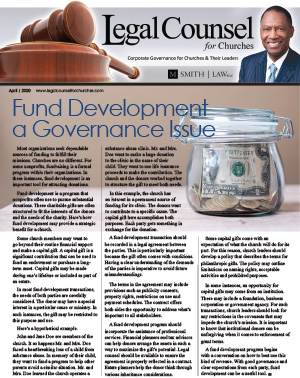Most organizations seek dependable sources of funding to fulfill their missions. Churches are no different. For some nonprofits, fundraising is a formal program within their organizations. In these instances, fund development is an important tool for attracting donations.
Fund development is a program that nonprofits often use to pursue substantial donations. These charitable gifts are often structured to fit the interests of the donors and the needs of the charity. Here’s how fund development may provide a strategic benefit for a church.
Some church members may want to go beyond their routine financial support and make a capital gift. A capital gift is a significant contribution that can be used to fund an endowment or purchase a long- term asset. Capital gifts may be made during one’s lifetime or included as part of an estate.
In most fund development transactions, the needs of both parties are carefully considered. The donor may have a special interest in a particular cause or ministry. In such instances, the gift may be restricted to this purpose and use.
Here’s a hypothetical example.
John and Jane Doe are members of the church. It so happens Mr. and Mrs. Doe faced a heartbreaking loss of a child from substance abuse. In memory of their child, they want to fund a program to help other parents avoid a similar situation. Mr. and Mrs. Doe learned the church operates a substance abuse clinic. Mr. and Mrs. Doe want to make a large donation to the clinic in the name of their child. They want to use life insurance proceeds to make the contribution. The church and the donors worked together to structure the gift to meet both needs.
In this example, the church has an interest in a permanent source of funding for its clinic. The donors want to contribute to a specific cause. The capital gift here accomplishes both purposes. Each party gets something in exchange for the donation.
A fund development transaction should be recorded in a legal agreement between the parties. This is particularly important because the gift often comes with conditions. Having a clear understanding of the demands of the parties is imperative to avoid future misunderstandings.
The terms in the agreement may include provisions such as publicity consents, property rights, restrictions on use and payment schedules. The contract offers both sides the opportunity to address what’s important to all stakeholders.
A fund development program should incorporate the assistance of professional services. Financial planners and tax advisors can help donors arrange the assets in such a way to maximize the gift’s potential. Legal counsel should be available to ensure the agreement is properly reflected in a contract. Estate planners help the donor think through various inheritance considerations.
Some capital gifts come with an expectation of what the church will do for its part. For this reason, church leaders should develop a policy that describes the terms for philanthropic gifts. The policy may outline limitations on naming rights, acceptable activities and prohibited purposes.
In some instances, an opportunity for capital gifts may come from an institution. These may include a foundation, business corporation or government agency. For such transactions, church leaders should look for any restrictions in the covenants that may impede the church’s mission. It is important to know that institutional donors can be unforgiving when it comes to enforcement of grant terms.
A fund development program begins with a conversation on how to best use this kind of revenue. With good governance and clear expectations from each party, fund development can be a useful tool.

